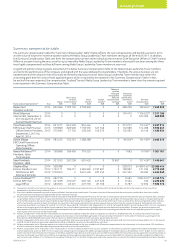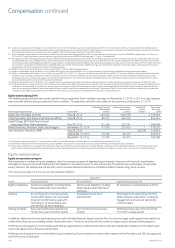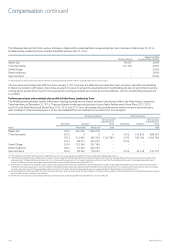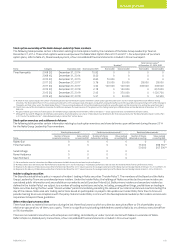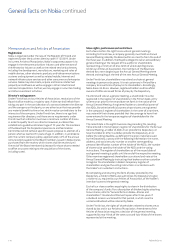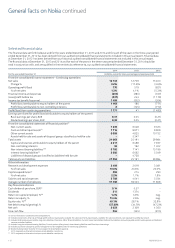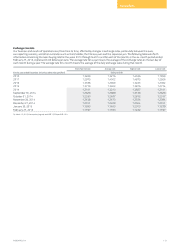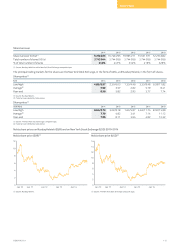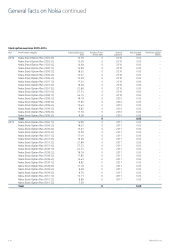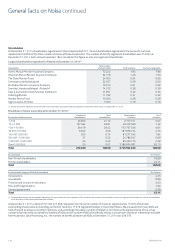Nokia 2014 Annual Report Download - page 110
Download and view the complete annual report
Please find page 110 of the 2014 Nokia annual report below. You can navigate through the pages in the report by either clicking on the pages listed below, or by using the keyword search tool below to find specific information within the annual report.108 NOKIA IN 2014
History of Nokia
Nokia has a long history of successful change and innovation, adapting
to shifts in markets and technologies. From its humble beginning with
one paper mill in 1865, the company has been part of many sectors
over time: cables, paper products, tires, rubber boots, consumer
and industrial electronics, plastics, chemicals, telecommunications
infrastructure and more. From the mid-1990s through to 2014,
manycame to know Nokia for its mobile phones, which reached all
parts of the globe. Then, in April 2014, Nokia began the next chapter
inits history with the Sale of the Device & Services Business (“D&S”).
Reinventing itself once again, Nokia changed its course and announced
that its strategy would focus on seizing opportunities in what can be
called the Programmable World.
150 years of reinvention
Nokia’s history dates back to 1865, when mining engineer Fredrik
Idestam set up his rst wood pulp mill at the Tammerkoski Rapids in
Southwestern Finland. A few years later he opened a second mill on
the banks of the Nokianvirta river, inspiring him to name the company
Nokia Ab in 1871.
In 1967, we took our current form as Nokia Corporation as a result
of the merger of Idestam’s Nokia AB, Finnish Rubber Works, a
manufacturer of rubber boots, tires and other rubber products
founded in 1898, and Finnish Cable Works Ltd, a manufacturer
of telephone and power cables founded in 1912. The new
Nokia Corporation had ve businesses: rubber, cable, forestry,
electronics and power generation.
Nokia rst entered the telecommunications equipment market
in 1960 when an electronics department was established at
the Finnish Cable Works with focus on the production of radio
transmission equipment.
Regulatory and technological reforms have played a role in
Nokia’s success over the years. The deregulation of the European
telecommunications industries stimulated competition and boosted
customer demand. In 1982, the company introduced the rst fully
digital local telephone exchange in Europe, and, in the same year,
the world’s rst car phone for the Nordic Mobile Telephone analog
standard. The technological breakthrough of GSM, which made more
ecient use of frequencies and had greater capacity, in addition to
high-quality sound, was followed by the 1987 European resolution to
adopt GSM as the European digital standard. On July 1, 1991, the rst
GSM call was made with a Nokia phone over the Nokia-built network
of a Finnish operator called Radiolinja, and in the same year, Nokia
won contracts to supply GSM networks to other European countries.
In the early 1990s, Nokia made a strategic decision to focus on
telecommunications as its core business, with the goal of establishing
leadership in every major global market. Basic industry and
non-telecommunications operations—including paper, personal
computers, rubber, footwear, chemicals, power plant, cable, aluminum
and television businesses—were divested between 1989 and 1996.
By 1998, Nokia was the world leader in mobile phones, a position it
held for more than a decade.
In 2006, Nokia, which had already been investing in mapping
capabilities for many years, acquired Gate5, a mapping software
specialist, and then in 2008, it acquired NAVTEQ, a US-based
manufacturer of digital mapping and navigational software. Today,
Nokia oers leading location services through the HERE business
and brand, launched in 2012.
General facts on Nokia
In 2007, Nokia combined its telecommunications infrastructure
operations with those of Siemens to form a joint venture named
Nokia Siemens Networks, also known has NSN. NSN became a leading
global provider of telecommunications infrastructure and services,
with a focus on oering innovative mobile broadband technology
and services.
In 2011, Nokia joined forces with Microsoft to strengthen its position
in the highly competitive smartphone market. Nokia adopted the
Windows Phone operating system for smart devices and smartphones
and through their strategic partnership, Nokia and Microsoft set
about establishing an alternative ecosystem to rival iOS and Android.
In 2011, Nokia also started to make a number of changes to its
operations and company culture that would in the course of the next
two years lead to shortened product development times, improved
product quality and better responsiveness to market demand.
In 2013, Nokia moved to reinvent itself once more, with two
transformative transactions. The rst was the purchase of Siemens’
stake in NSN, which was nearing the end of a deep restructuring and
remarkable transformation. The second was the announcement of the
Sale of the D&S Business. The Microsoft transaction was announced
on September 3, 2013 and was completed on April 25, 2014.
Following the closing of this transaction, Nokia announced its new
vision and strategy, building on its three businesses; Nokia Networks,
HERE, and Nokia Technologies. The rapidly evolving world of
technology provides the context for Nokia’s vision and strategy, which
focuses on connecting things as well as people. Nokia expects to see
more than 50 billion connected things globally by 2025. Nokia sees
itself as one of the companies at the center of this change, creating
new possibilities for our customers, our partners, and consumers.
In the context of the Programmable World, Nokia intends to build on
its strengths like Nokia Networks’ mobile network expertise and strong
relationship with operators; HERE’s expertise in connected cars and
relationships with car manufacturers; and Nokia Technologies’ insights
and innovation in sensors and new technologies. With these strong
assets, Nokia is ready for the next chapter in its 150-year history.
Acquisition of Siemens’ stake in NSN
Nokia announced the rst of what would be two transformative
transactions for the company during 2013 on July 1 when it
announced an agreement to acquire Siemens’ 50% in the companies’
joint venture Nokia Siemens Networks, pursuant to the Share Purchase
Agreement by and among Siemens AG, Siemens International Holding
B.V., Nokia Finance International B.V. and Nokia Corporation dated July
1, 2013. The purchase price for Siemens’ stake was EUR 1.7 billion and
the transaction closed on August 7, 2013, at which time NSN became
a wholly owned subsidiary of Nokia.
After the transaction closed, we phased out the Siemens name from
Nokia Siemens Networks’ company name and branding and adopted
Nokia Solutions and Networks, or NSN, as the name and brand. Upon
the announcement of our new strategy on April 29, 2014, NSN is now
known as Nokia Networks and operates under the Nokia brand.



